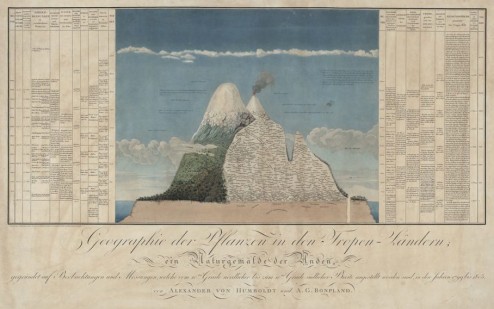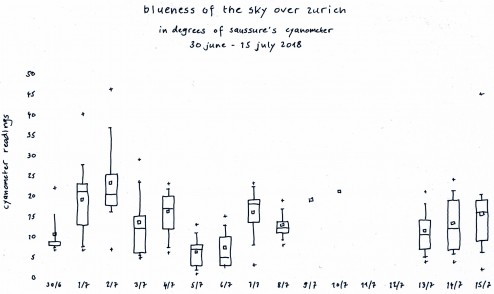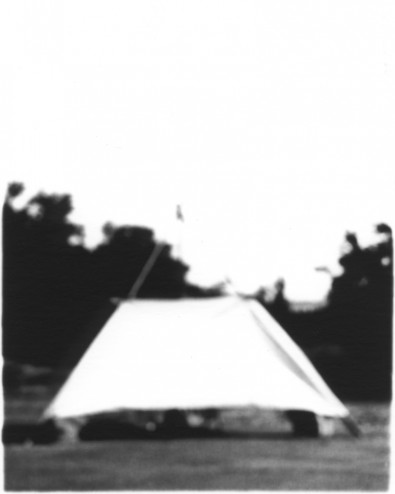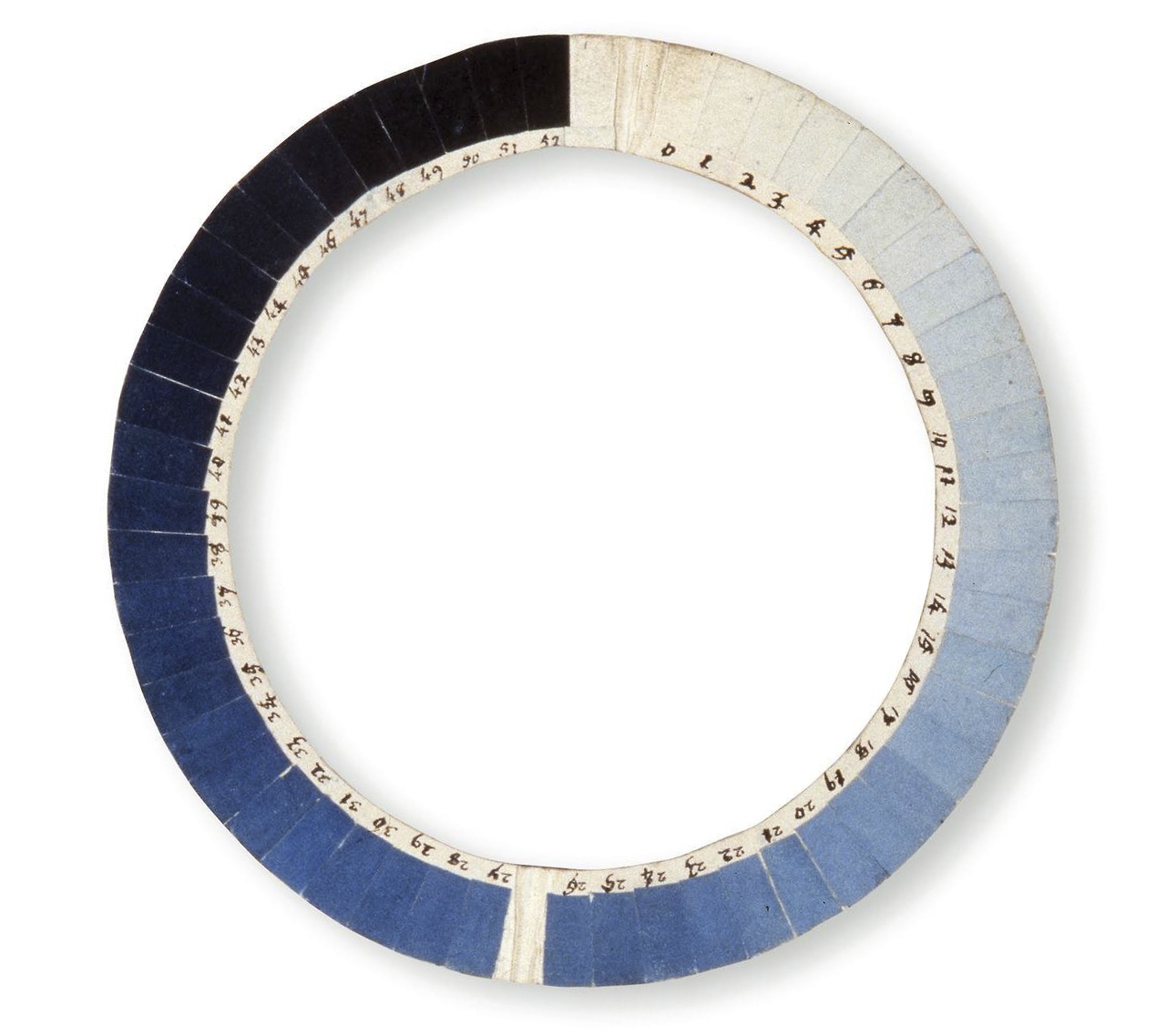"er hatte die farbe des himmels gemessen, die temperatur der blitze und die schwere des nächtlichen rauhreifs, er hatte vogelkot gekostet … "
“he had measured the colour of the sky, the temperature of lightning and the weight of nightly hoar frost, he had tasted bird droppings … “
daniel kehlmann on alexander humboldt (die vermessung der welt / measuring the world, 2005)
bleu, blanc, noir is part punk science experiment, part temptation to rest and meditate. both parts point towards the sky over zurich, of which we rarely take much notice, our view obstructed by buildings, our attention drawn to market barkers.
early scientists of the late 18th century climbed mountains to come back down with notebooks full of measurements, lyrical accounts and sketches (the arts and the sciences hadn’t split up yet, the sciences not splintered into specialities, and photography was only about to be invented). horace-bénédict saussure reached the top of mont blanc in 1787, alexander von humboldt made it not quite to the peak of chimborazo in 1802.
bleu, blanc, noir treads in the footsteps of such explorers but remains in the serene lowlands of zurich. those who trust in numbers may pick up a cyanometer. for a poetic view of the colours of the sky: recline on a deck chair in the observatory tipi.
part one: measurements / cyanometer
invented by horace-bénédict saussure, the cyanometer is a rudimentary instrument for quantifying the blueness of the sky. his 1788 model is pictured above: a circular colour scale in 52 shades of prussian blue ranging from white to black.
the device seems easy to use: hold the ring up to the sky, compare the blue of the sky with the colour scale, write down the reading.

saussures first measurements of the blueness of the sky, published in 1790 with instructions for a reproducible fabrication of a cyanometer (sources see below).
alexander von humboldt* took a saussure cyanometer on his explorations of latin america and devoted a column in his large-format naturgemälde to the colours of the sky.

‘geographie der pflanzen in den tropen-ländern – ein naturgemälde der anden’ (alexander humboldt and aimé bonpland, 1807). the data illustrate how the sky becomes darker with altitude (8th column: bläue des himmels in graden des kyanometers). via zentralbibliothek zürich. klick on the image for a larger file.
between 30 june and 15 july 2018 visitors of two festivals in zurich were asked to contribute measurements using a miniature cyanometer. over 150 data sets and one photograph of chimborazo were sent in*. here is a synopsis:

blueness of the sky over zurich in degrees of saussure’s cyanometer, 30 june – 15 july 2018. on sunny days averages are in the range of 15-20, in agreement with the 1790 values measured in geneva. on cloudy days (5 and 6 july) between 5 and 10. see here for a more detailed discussion of the figure and the results of the experiments.
part two: poetry / tipi
the observation tipi serves for stretching out on deck chairs and observing the sky. it is built like an outsize triangulation pyramid (as sometimes found on mountain tops) but inverted (it stands in the flatlands): the lower half is covered with cloth, through the open upper half the sky can be seen.

observation tipi. bamboo poles, fabric, palm fiber rope, coffee bags, stone.
the tipi provided an unintended but appreciated soundscape of creaking wooden masts and flapping sails.
a notice suggested sending out postcards with a cut-out cyanometer (provided in a box).
i know nothing of the missives dispatched but one visitor-explorer confessed that he was „… more intrigued by the sailing ship noises than the blue of the sky and that the scent inside the tipi reminded him of a geographer he once was in love with, who always had a whiff of freshly laundered linnen around her, to whom he will now write home from months at sea, imagined half-asleep …“
others just fell onto the chairs to sleep it off.

hms beagle (charles darwin, 1831-1836). via wikimedia commons.
“il était une fois, dans le grand nord, vers thulé, la brève pénombre bleue qui fait office de nuit, il était une fois le jaune joyeux du ciel avant que le soleil ne se réveille (…), il était une fois cent sortes de gris, il était une fois le ciel bleu revenant vite le lendemain, comme de crainte d’avoir été oublié (…)”
erik orsenna, 2010, l’entreprise des indes
bleu blanc noir was a contribution to the festival living room (edition 2018) and to the lüchtturm festival. thanks to jürg baruffol, vincent pearlstein and kaffeepur.
* footnotes
up to counterfactual historians to imagine how humboldt’s expeditions (as an early enthusiast of daguerrotypes) and their harvest might have been different had he taken along cameras, glass plates, dark room tents …
the colours of the sky are also studied to understand changes in the atmosphere, both natural and man-made. for example: zerefos and colleagues study paintings hundreds of years old for estimating the effects of volcanic eruptions that could not be measured at that time. john ruskin (not read in the original) seemed to have seen early industrial pollution in the changing colours of sunsets.
thanks to anita schneider and mischa classen (who regrettably set off for ecuador without a cyanometer) for the chimborazo picture.
sources
horace-bénédict de saussure. 1790. description d’un cyanomètre ou d’un appareil destiné a mesurer l’intensité de la couleur bleue du ciel. mémoires de l’academie royale des sciences à turin, 1788-1789, 409-424.
stéphane fischer. 2014. horace-bénédict de saussure, naturaliste des alpes.
andrea wulf. 2015. the invention of nature.
lord byron. 1819. don juan.
pedro lilienfeld. 2004. a blue sky history. optics & photonics news.
olaf breidbach and andré karliczek. 2011. himmelblau — das cyanometer des horace-bénédict de saussure (1740–1799). sudhoffs archiv, 95 (1), 3-29.
olafur eliasson. 2014. colour experiment no. 66 (cyanometer).
zerefos et al. 2007. atmospheric effects of volcanic eruptions as seen by famous artists and depicted in their paintings. atmospheric chemistry and physics 7.
annina boogen. 2019. das blau des äthers. aether 03.
image of the cyanometer: musée d’histoire des sciences, genève (via wikimedia commons).
